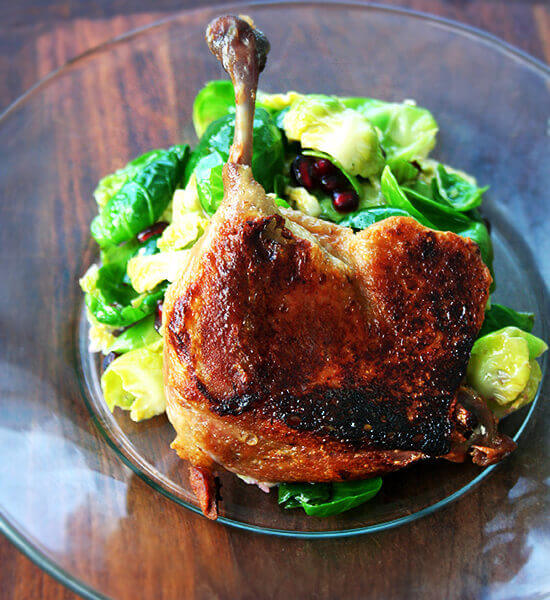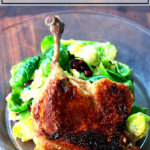Description
This is not a recipe for making traditional duck confit, which tends to be a lengthy three-phase process of salting, rinsing and then simmering in fat. Rather, it’s a recipe inspired by the duck confit made by Chef Thien Ngo at Fork, when he discovered his many-years old supply had been mistakenly trashed.
Traditionally, too, confit is stored in fat, which will preserve it for months. You certainly could do that, but if you plan on crisping up the legs within a few days, it’s easier to store the legs and fat separately.
Serve the confit with a simple green salad tossed in a shallot vinaigrette. Do not be deterred by the amount of fat here (or in any confit recipe). Very little fat ends up in the meat, and the duck confit itself does not taste fatty.
Ingredients
- 4 duck legs
- 1 tablespoon kosher salt
- 1 lb. butter
Instructions
- Preheat the oven to 325ºF.
- Place duck legs in a 9×13-inch or other similarly sized baking pan — you want them to fit somewhat snuggly (more snug than what you see in the pictures is just fine). Sprinkle with the tablespoon of kosher salt. Cover legs with sticks of butter, breaking the sticks in half if necessary. Cover pan tightly with aluminum foil — use a couple of sheets of foil if necessary. Be sure to wrap tightly.
- Bake for 2.5 hours. Remove pan from oven. Let cool briefly, then remove foil to cool completely. Once cool enough to handle, transfer legs to a plate (if serving immediately or within the next few hours) or a storage container (if serving on subsequent days). Transfer fat to a storage container. Label it duck fat. Store in fridge indefinitely. When you make confit again, use this fat in place of butter. (Note: You may need to pop your vat of duck fat in the microwave so that you can pour it out of its container. Alternatively, plop the container into hot water, or let it sit at room temperature for a few hours.)
- If possible, bring the cooked duck legs to room temperature an hour before cooking. If you feel like being fancy, use the heel of your knife to whack off the top half of the bone nub at the end of each duck leg (see photo for guidance). Also, trim off any fat extending up the bone. Note: this is purely for presentation purposes and truly is not necessary.
- Preheat the oven to 350ºF. (Note: preheating the oven is only necessary if you’ve stored your legs in the fridge.) Heat a cast iron skillet over medium heat. You should not need to add any fat to the pan — the duck legs should have enough fat clinging to their skin sides. Once hot, add duck legs skin side down. Let them crisp undisturbed for a minute or two. Shake the pan to make sure the skin isn’t sticking. If it is, use a spatula to gently separate the legs from the pan, being careful not to tear the skin. Continue crisping, repositioning the legs if necessary to ensure the skin is browning evenly, about 5 to 8 minutes total. If the legs have been refrigerated, once the skin is nicely crisped, transfer pan to the oven (no need to flip the legs over) for 5 to 10 minutes or until the meat is nicely heated through. If the legs have not been refrigerated, you probably can get away with just flipping the legs over and cooking for one minute skin side up. You don’t want to cook the legs too much on the flesh side or the meat will get too tough.
- Prep Time: 5 minutes
- Cook Time: 2 hours 45 minutes
- Category: Dinner
- Method: Oven
- Cuisine: French

